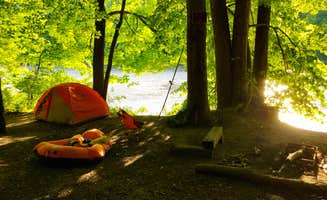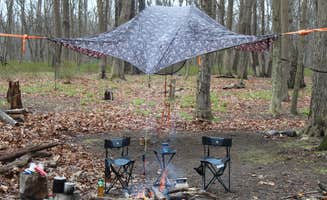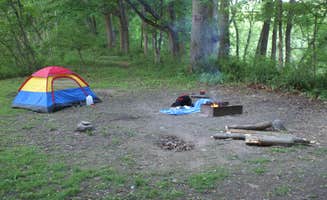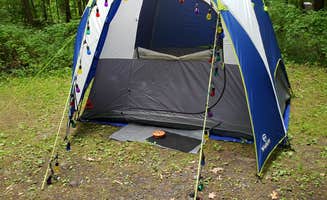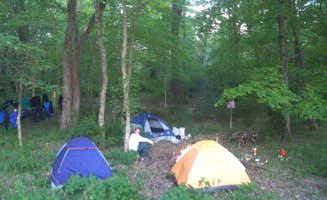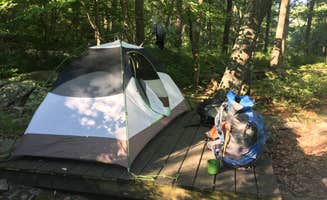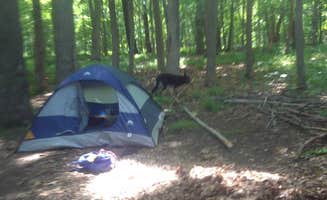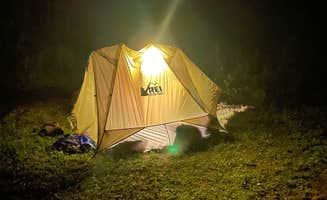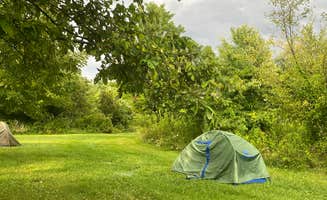Delaware Water Gap primitive camping options near Rowland, Pennsylvania primarily consist of river access sites maintained by the National Park Service. These tent-only sites sit at approximately 300-400 feet elevation along the Middle Delaware River within the Delaware Water Gap National Recreation Area. Most primitive sites require paddling access and implement a strict one-night stay policy since they're designed for river travelers continuing downstream the next day.
What to do
Waterfall exploration: 10-15 minute hike from Sandyston Boat In Campsites across the river to Raymondskill Falls on the Pennsylvania shore. A reviewer notes that "on the Pennsylvania side of the river you can hike to Raymondskill Falls, one of many in easy walking distance, as well as search for abandoned/forgotten homes and mills, some of which date back to the 1700's."
Fossil hunting: The Delaware Water Gap area contains numerous paleontological sites. Campers at Sandyston Canoe Camping report you can "try your luck at fossil and artifact hunting" along riverbanks and surrounding terrain.
McDade Trail access: The multiuse trail connects many river camping sites. From Hornbeck's River Campsites, "a short walk upriver on the trail will bring you to the Dingman's Campground, whose store has ice cream and cold drinks and to Hornbeck Creek waterfall trail."
Paddling loops: Many campers combine overnight stays with multi-day paddling trips. One paddler at Namanock Island described a route where "we packed up and set off for another site about 8 miles down the river. After camping at the next site we packed up and hiked back along the McDade Recreation Trail to Dingmans Ferry access where we caught the River Runner Shuttle."
What campers like
Stargazing conditions: Primitive campsites offer exceptional night sky viewing due to minimal light pollution. A camper at Namanock Island explains that "once darkness falls there are no lights to be seen in either direction, up or down river. You are camped on the side of the island that views Pennsylvania's shore. Now, no lights means an incredible view of the night sky."
Wildlife viewing: The area provides numerous opportunities to spot local fauna. One paddler mentions, "Saw tons of bald eagles flying near the site and while paddling birds playing and baby geese with their mommas!"
River sounds: Many campers appreciate the natural soundtrack at waterside campsites. One reviewer states that Namanock Island "is so serene and peaceful, you'll hear the water flowing gently all night, perfection!"
Island camping experience: Steam Mill Campground provides access to nearby hiking trails with views. "The campground is along the Blue Loop trail, providing either an easy walk along the stream or an easy/moderate hike that connects to the AT with views at Sunrise Mountain. I made a fairly easy 9-mile loop."
What you should know
Landing challenges: River shorelines can make loading and unloading difficult. A camper notes that sites have "a very steep and above average height to the shoreline making unloading both more tiring and more of a hazard than I prefer."
Site competition: During peak season, securing a site can be challenging. A reviewer at Hornbeck's River Campsites cautions: "During the summer, it is often a challenge to find an open site on a Saturday night, especially if you have gotten a late start on the river or are approaching the southern end of the park."
Complete self-sufficiency required: No facilities exist at most primitive sites. One camper explains that at Namanock Island, "This is primitive camping... No bathrooms, no facilities of any sort. Everything must be packed in and out, or you wont have it."
Return paddling challenges: Consider travel logistics carefully. A solo paddler at Namanock Island warned, "I also thought it would be a good idea to paddle down stream and back up to Milford beach. Boy was I wrong! Took about 4.5 hours to paddle 3 miles then had to wave down a boat to tow me the rest of the mile. Was not fun!"
Tips for camping with families
Choose sites with easier shore access: Some river sites have gentler approaches than others. When camping with children, select locations with gradual shorelines for safer loading and unloading.
Site spacing considerations: For family groups needing multiple tents, certain sites offer more space. A camper at Port Jervis Elks Brox Hiker/Biker Campground notes they found a spot "right across from the lake in amongst a copse of trees," providing natural boundaries that help contain active children.
Bring backup water transportation: Having additional paddling options can provide safety margin. A reviewer cautioned about river currents affecting return trips, suggesting families should arrange shuttle service or bring sufficient adults to manage unexpected paddling challenges.
Know your capacity: Sites vary in size considerably. At Namanock Island, "The island is large enough for all. Sites 2 and 3 are much better suited for 2-3 people and hammock camping, but can handle tents. Site 4 is the second largest on the island and is situated at the end of the island and a little more secluded from the others, in my opinion 4 is a great site for a family or group of 3-6."
Tips for RVers
Limited RV access to primitive sites: Most tent camping near Rowland requires water access only. For RV travelers seeking primitive experiences, consider Minisink Campground which offers both boat-in and drive-in access with basic amenities including drinking water, picnic tables, showers and toilets.
Vehicle considerations: Even road-accessible campgrounds have limitations. A visitor at Port Jervis Elks Brox Hiker/Biker Campground advises, "I would not drive an RV in here except maybe a small type trailer."
Alternatives for larger RVs: When traveling with RVs, utilize developed campgrounds as a base and access primitive tent sites via day trips. Steam Mill Campground offers drive-in camping while maintaining a rustic experience with limited amenities.




